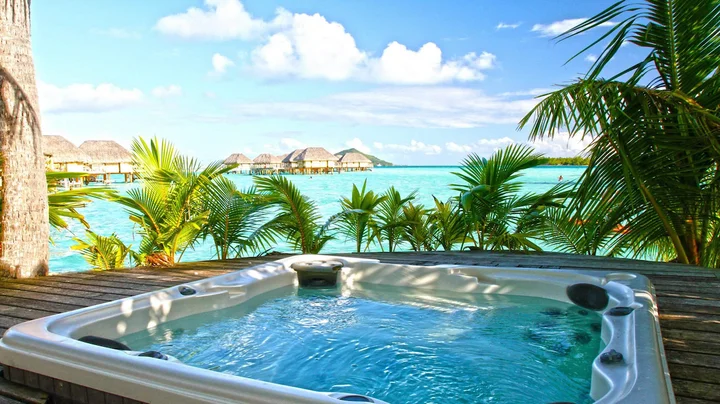Can All Hot Tubs Use Salt Water?

If you’re in the market for a hot tub or are already a proud hot tub owner, you may have heard good things about salt water systems. Proponents of saltwater hot tubs often speak of odour-free, soft and smooth water, simpler maintenance regimes and less reliance on harsh chemicals.
There are saltwater hot tubs that you can still buy today – a few manufacturers still make and sell them. You can even convert your traditional hot tub to a saltwater tub if you’re so inclined.
We are asked about them at Hydropool and we used to manufacture them and sell them, but we don’t anymore. For the most part, we believe that while saltwater had its day, there are modern methods that are better and easier ways to create sanitized water and reduce chemical usage (we will explain that a bit later on).
But we are still asked about it! And we understand why: The allure of saltwater is there. It’s used in pools and works well today, so why not in hot tubs? We will explain it all, under the following categories:
- What is a saltwater hot tub?
- How does a saltwater hot tub work?
- How easy is converting a conventional hot tub to run on salt water?
- Did Canada ban saltwater hot tubs?
- Why haven’t saltwater hot tubs caught on in a bigger way?
We hope by the end you’ll have a strong sense of whether saltwater is right for you when it comes to making your hot tub purchase.
What is a Saltwater Hot Tub?
A saltwater hot tub is exactly what it sounds like - a hot tub that uses saltwater for sanitization - but for most people, it doesn’t work how they think it will. Let us explain.
How Does a Saltwater Hot Tub Work?
Conventional hot tubs rely on the addition of chlorine or bromine to keep the water clean, safe and fresh. Saltwater hot tubs, instead, require the addition of salt to the water which is subsequently broken down by electrolysis into its constituent parts of sodium and chlorine by a mechanism known as a saltwater chlorinator or chlorine generator.
So any saltwater hot tub is still sanitized with chlorine. This is something most people don’t realize until they get serious about shopping for a saltwater hot tub: You’re not removing chlorine from the process, just adding it in a different way to your hot tub.
But you no longer need to directly apply chlorine directly to the water. The chlorinator slowly and systematically breaks down the salt to create a constant and balanced supply of sanitizing chlorine.
Although hot tub or swimming pool salt is chemically the same as table salt, it comes in a much coarser form that is designed to be broken down by the chlorinator. Swimming pool and hot tub dealerships and supply stores sell this specialized salt by the bag or container.
When properly added to the hot tub water, the concentration of salt is actually as much as 10 times less than that found in ocean water. It’s at even a lower concentration than that found in human tears. This is done to try and minimize the effects of corrosion that saltwater has on metal parts.
Can I Make My Hot Tub Saltwater?
With the installation of either an in-line or drop-in saltwater chlorinator, it’s possible to convert any hot tub to use saltwater.
- In-line systems are attached directly to the plumbing system, usually in the cabinet of the hot tub which makes them somewhat more difficult to install than drop-in systems. But the finished product is far less intrusive: you don’t have a big chlorinator sitting out in the open.
- Drop-in systems are simple plug-and-play operations that use a standard plug-in. They are composed of a small chlorinator cell that’s attached to a control panel and hung over the edge of the hot tub and submerged in the water. Because most chlorinators don’t need to run constantly, it’s possible to remove the chlorinator cell while the hot tub is being used.
The systems cost anywhere from $500 to $1000 Cdn, depending on what you’re looking at, plus the effort/cost to install. You can get them at pool supply stores or sites like Amazon.
A note of caution! Check your warranty before trying this: You will want to make sure that your warranty allows you to try a saltwater system. If in doubt, contact your retailer.
Are Salt Water Hot Tubs Better?
Are they better than a standard chlorine or bromine hot tub? Well, there are tradeoffs.
- Saltwater hot tubs can be more simple to maintain than regular chlorine-based systems.
- Saltwater systems are less prone to large fluctuations in chemical levels meaning that you’ll spend less time adjusting the water chemistry and use fewer chemicals while doing so.
- However, you’ll need to clean and replace the chlorinator cell regularly and keep an eye on any metal components to ensure that rust isn’t forming, and that corrosion isn’t taking place.
- There are also better, more modern systems that reduce chemical usage more than saltwater systems do.
Why Haven’t Saltwater Hot Tubs Caught on in a Bigger Way?
There are a few reasons for this. A few companies like Caldera and Hot Spring and Arctic still sell saltwater hot tubs. But they haven’t taken over the market or anything close.
- At Hydropool, when we sold them, over time we found that reliability was an issue. Salt is corrosive and it becomes hard to manage over time, no matter how often you wipe down your metal parts.
- We also found them to be more complex to use for people. We have seen manuals from some companies that are much larger than what’s required for a more traditional system (and especially our simplified self-cleaning system).
- Modern sanitization systems reduce chemicals and are easier to use, making them a better option for anyone trying to reduce chemicals. Hydropool developed a system that uses UV light plus ozone in what we call our PureWater system, and it allows for less chemical usage than saltwater hot tubs. Most other quality hot tub makers have taken a similar approach. These are called AOP systems, for advanced oxidization process.
- Here’s how AOP systems work compared to salt: Salt systems continually produce chlorine, treating the bacteria and contaminants that are continually growing inside the water. AOP systems are preventative, rather than reactive like saltwater systems, which activate once bacteria is created. AOP systems stop growth before it requires higher amounts of chlorine. Hydropool’s Purewater system requires as little as 1 ppm sanitizer to keep the water safe and healthy. For that reason, we think they are better. We see it as a more natural way of purifying water that reduces the amount of chemicals you use (the approach to an AOP system is based on how water treatment centres treat our drinking water).
- Salt systems work better in pools because the larger amount of water, which can hold a larger amount of salt simply does more work than a smaller amount of salt, even in a smaller amount of water.
- Canada does not allow bromine salt generators as of 2020, declaring them carcinogenic. So your sole choice is salt-generating chlorine: bromine users are out of luck.
Can You Make a Hot Tub a Salt Water Hot Tub?
The answer to that is unquestionably yes. You can buy an aftermarket attachment that will convert salt to chlorine in your hot tub. It ultimately works the same way if you had bought a saltwater hot tub in the first place. Pricing ranges from $500 to $1000, plus installation.
Should you bother? That’s up to you. We used to sell saltwater hot tubs at Hydropool but abandoned them around 2016. We found, like most manufacturers, that there are better ways of minimizing chemicals in your hot tub water without resorting to saltwater, which creates a host of issues (most of them involving reliability).
We also found that the reliability issues made them not worth the effort. But we acknowledge that some people simply prefer saltwater hot tubs to this day, so we understand why you or anyone would consider it as an option.
Have more questions on saltwater systems? Don’t hesitate to reach out to us by contacting the retailer closest to you here.






